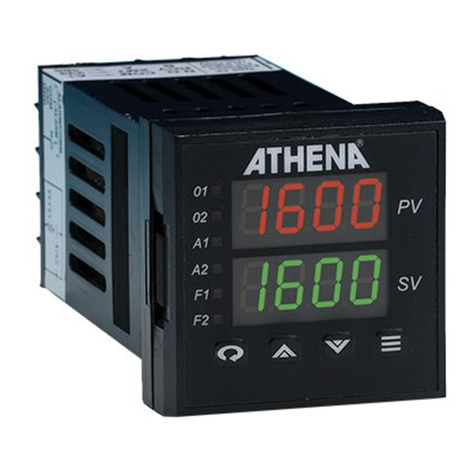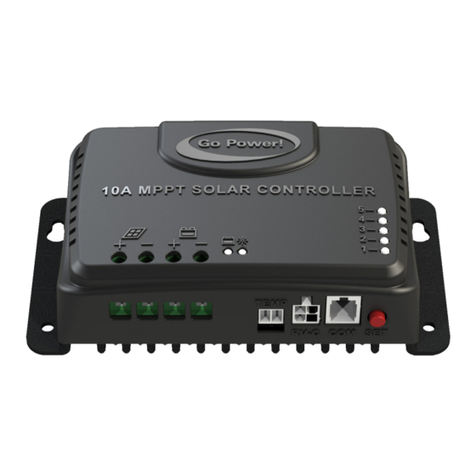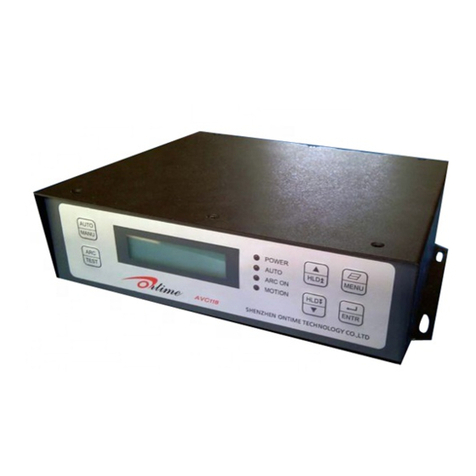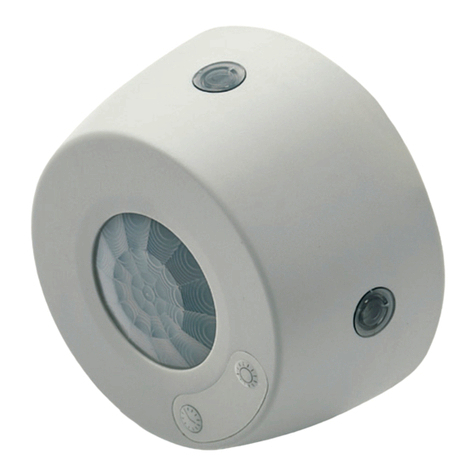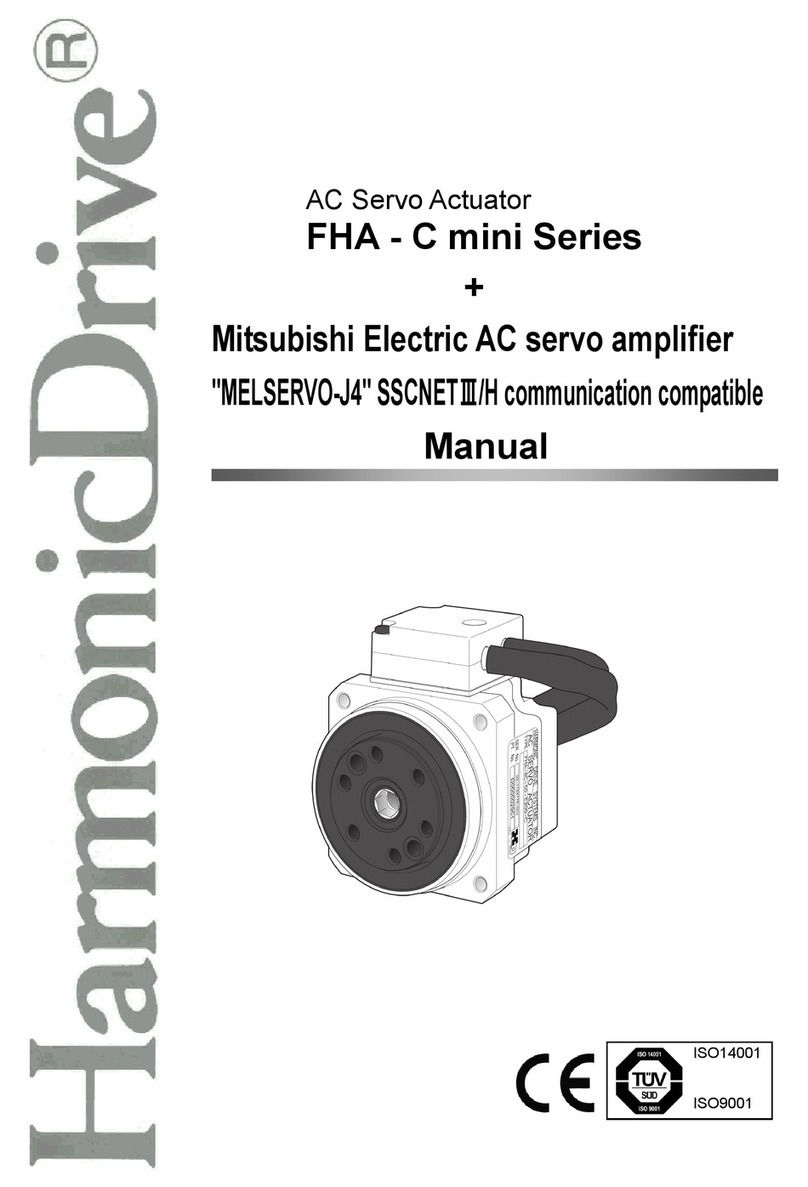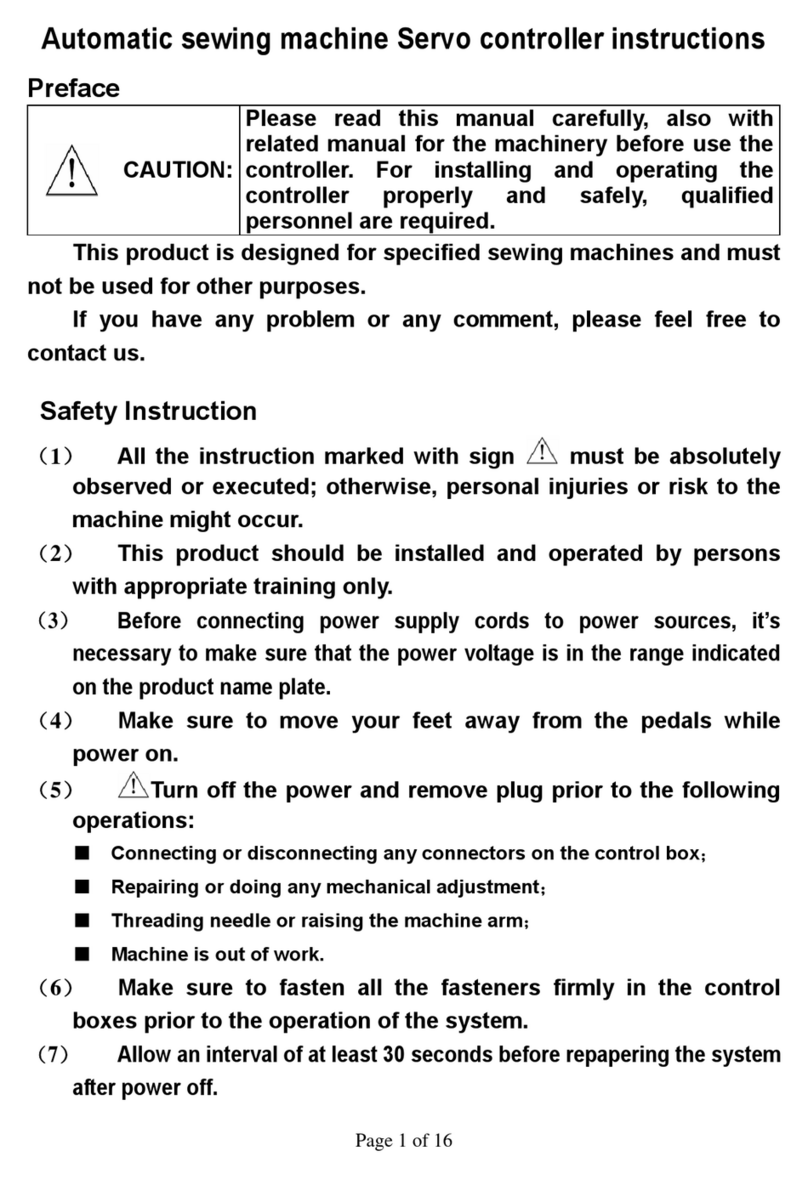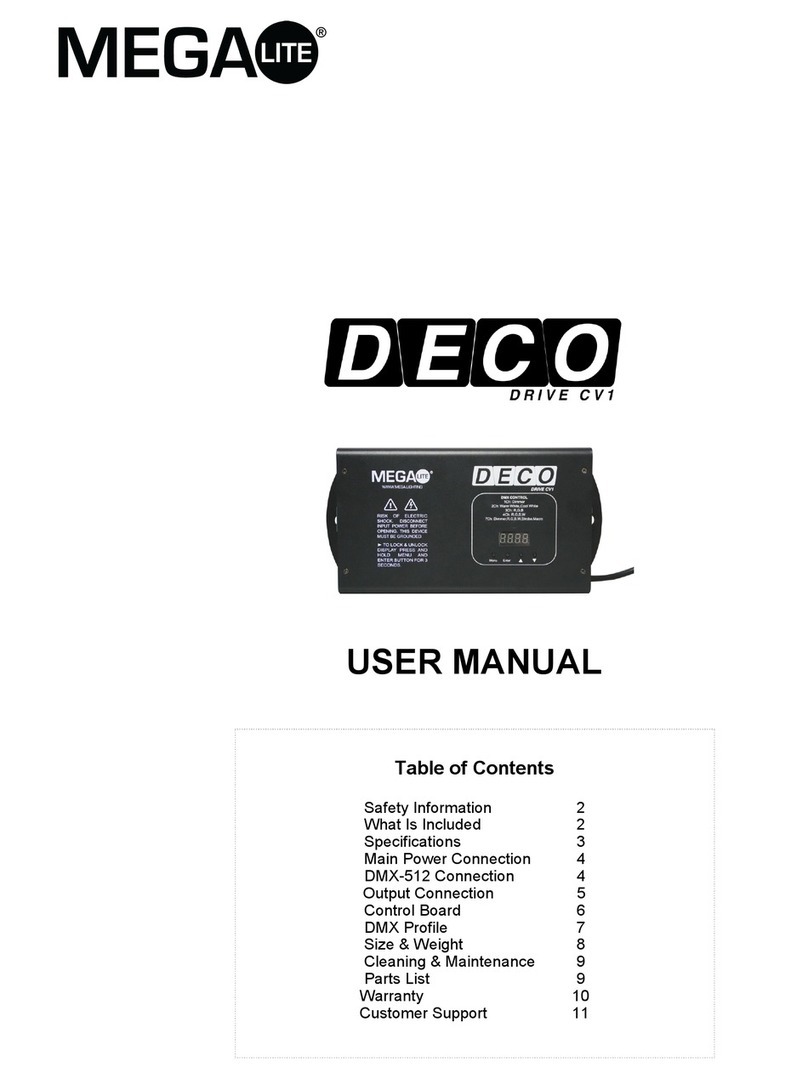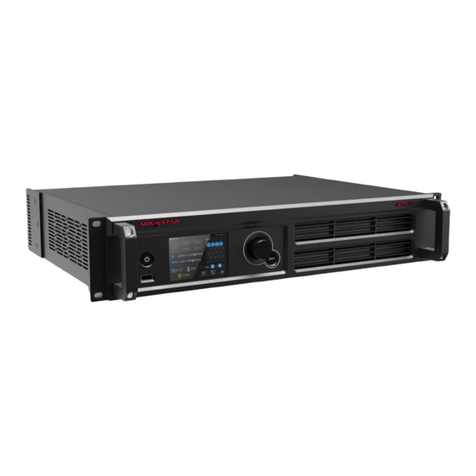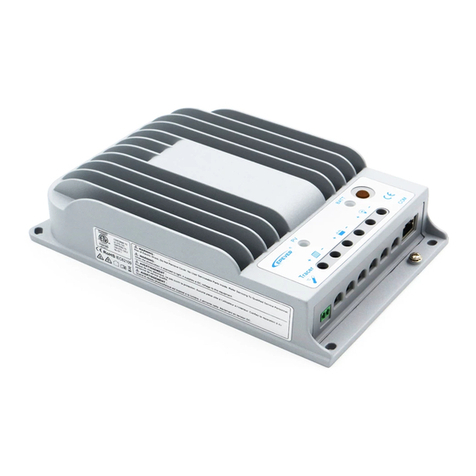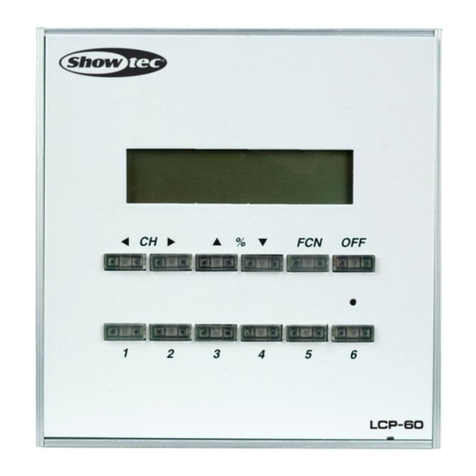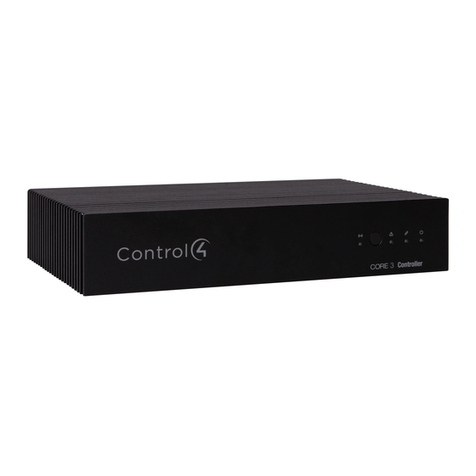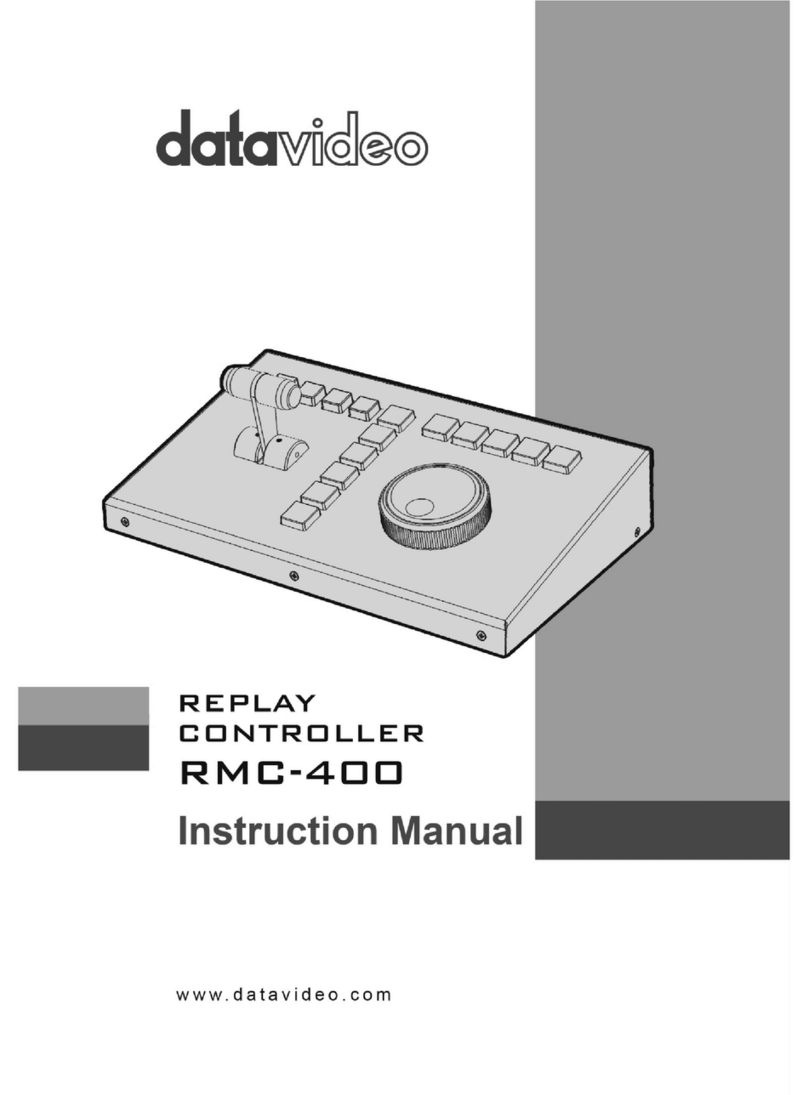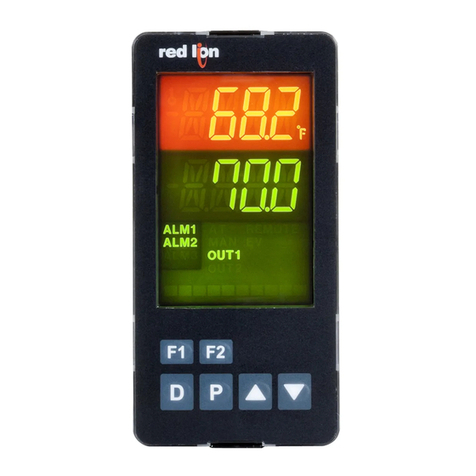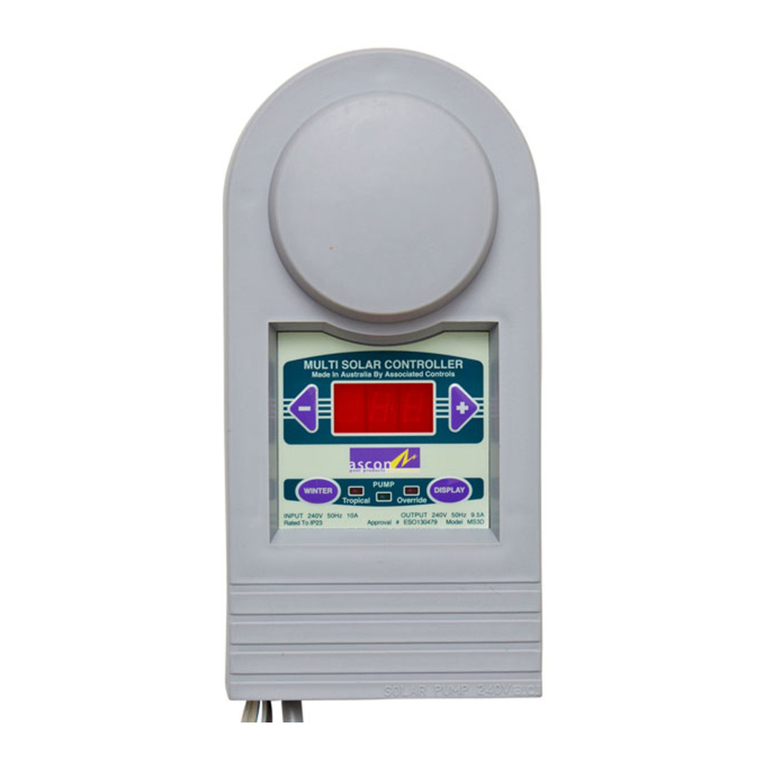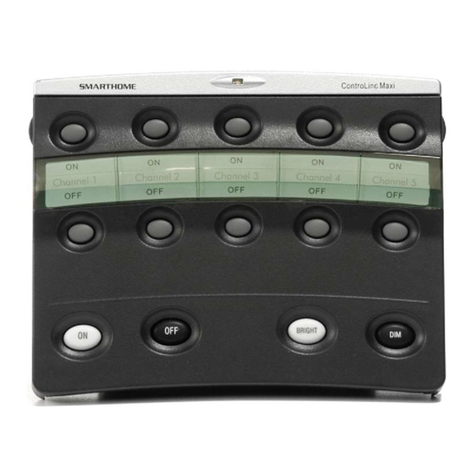Athena Controls RMB/12 User manual

Athena®RMB/6 and RMB/12
Non-Modular Hot Runner
Controller
Configuration and Operation
Manual

Athena®, CompuStep®, and CompuCycle®are registered trademarks, and RMB/6™ and
RMB/12™ are trademarks of Athena Controls, Inc.
©2012. Athena Controls, Inc. All rights reserved.

Precautions
Warning
Use of this equipment in a manner not specified by the manufacturer may
impair protection provided by the equipment.
In addition to presenting a potential fire hazard, high voltage and high
temperature can damage equipment and cause severe injury or death.
When installing or using this instrument, follow all instructions carefully
and use approved safety controls.
Hazardous potentials exist on components inside the controller. Always
disconnect AC power to the controller when servicing the controller.
Because these temperature controls or associated equipment may not
always fail safe, an approved temperature and/or pressure safety control
should be used for safe operation.
Turn off power to the controller before cleaning the exterior of the
controller.
Failure to observe these precautions can result in exposure to a potentially
lethal shock hazard.
All wiring should be done by an experienced technician. The controller and
wiring should be installed in accordance with national and local electrical
codes. To avoid serious personal injury and damage to equipment, follow
all warnings and cautions provided in the hardware setup instructions.
Caution
If a controller shows signs of having been damaged during shipping, do not
power up or install the controller. Save all packing materials and report any
damage to the carrier immediately.
Do not locate this instrument where it may be subjected to excessive shock,
vibration, dirt, moisture, oil, or other liquids.
This is a Class A product. In domestic environment this product may cause
radio interference in which case the user may be required to take adequate
measures.
Specified operating ambient temperature is 32 to 122 °F (0 to 50 °C).
I

RMB/6 and RMB/12 Hot Runner Controller Configuration and Operation Manual
900M243U00 ©Athena Controls, Inc. i
Table of Contents
Precautions........................................................................................................... I
1. Introduction ............................................................................................... 1
1.1 About This Manual ................................................................................................1
1.2 Features and Benefits of RMB/6 and RMB/12 Controllers ...................................1
1.3 Model Number Breakdown ...................................................................................3
1.4 What Happens When You Power Up the Controller.............................................4
2. Setup Sequence ........................................................................................ 5
3. User Interface ............................................................................................ 8
3.1 Overview ...............................................................................................................8
3.2 Selecting One or All Zones .................................................................................10
3.3 Mode of Operation ..............................................................................................10
3.4 Changing the Setpoint ........................................................................................11
3.5 Changing a Configuration Parameter Value .......................................................11
3.6 Configuration Menus and Factory Settings.........................................................12
4. Alarms and Alarm Indication ................................................................. 14
4.1 Types of Alarms ..................................................................................................14
4.2 Alarm Indication ..................................................................................................14
4.3 Silencing Alarm Beep..........................................................................................14
4.4 External Indication ..............................................................................................14
4.5 Alarm Priorities....................................................................................................15
5. Parameter Characteristics...................................................................... 16
5.1 Introduction .........................................................................................................16
5.2 Input Parameters ................................................................................................16
5.3 Boost Parameters ...............................................................................................17
5.4 Control Parameters.............................................................................................18
5.5 Display Units .......................................................................................................20
5.6 Alarm Parameters ...............................................................................................21
5.7 Supervisor Parameters .......................................................................................22
6. Tuning the Controller for PID Control ................................................... 23
6.1 Introduction .........................................................................................................23
6.2 Procedure for Autotuning ....................................................................................23
6.3 Autotune Errors...................................................................................................25
6.4 Manual Tuning (Zeigler-Nichols PID Method).....................................................25
7. Restricting Access to Controller Functions ......................................... 27
8. Resetting Parameters to the Default Values......................................... 28
9. Index......................................................................................................... 29
Warranty............................................................................................................. 31

RMB/6 and RMB/12 Hot Runner Controller Configuration and Operation Manual
1.Introduction
1.1 About this Manual
This manual contains all the information needed to configure and operate the RMB/6 and
RMB/12 Non-Modular Hot Runner controllers.
Wiring diagrams, mounting instructions, and other information about installing the
hardware are on the installation diagrams shipped with the unit.
1.2 Features and Benefits of RMB/6 and RMB/12 Controllers
1.2.1 Multi-Zone Control with Convenient User Interface
A single RMB/6 Hot Runner controller can provide microprocessor-based control of up to
six zones; a single RMB/12 Hot Runner controller can control up to twelve zones. Zones
can be configured individually or all zones can be configured simultaneously.
During operation the front panel simultaneously displays the process value and setpoint
for every zone. LEDs for each zone indicate the type of control (open or closed loop),
output status, alarm status, boost status, and standby status. Buttons on the front panel
make it easy to change the setpoint, mode, and configuration parameter values for one
selected zone or all zones.
The front panel also has buttons to:
•start the boost for all zones,
•put all zones in Idle or all Idle zones in the Run state,
•silence the audible alarm.
When necessary, access to function buttons on the front panel can be restricted. See
Section 7for details.
RMB 6 Operating Display
900M243U00 ©Athena Controls, Inc. 1

RMB/6 and RMB/12 Hot Runner Controller Configuration and Operation Manual
2 ©Athena Controls, Inc. 900M243U00
RMB 12 Operating Display
1.2.2 PID Control with Autotuning
When an RMB/6 or RMB/12 zone is in Normal (closed loop) mode, Proportional-Integral-
Derivative (PID) control is provided. The RMB/6 and RMB/12 Hot Runner controllers also
support Manual (open loop) mode that overrides automatic control. In Manual mode you
control the output by entering a fixed output percentage value.1A zone’s transfer from
PID to manual is “bumpless” when the process value is within 9 °F (5 °C) of the setpoint.
Using PID control, the controller modulates output power by adjusting the output power
percentage within a configurable proportional band. Power is proportionally reduced as
the process temperature gets closer to the setpoint temperature.
The configurable derivative action affects the output based on the rate of change of the
process value.
The integral action affects the output based on the duration of the process value’s
variation from the setpoint. In the RMB/6 and RMB/12 Hot Runner controllers, the
integral (reset) action is always equal to six times the configured derivative (rate) action.
An Autotune function is standard on every RMB/6 and RMB/12 Hot Runner controller.
This feature for easy tuning of the proportional and derivative components of the control
algorithm can be initiated every time the controller is powered up, once when the
controller is set up regardless of success (and again by changing a parameter value),
once only if successful (repeated at each power up until successful), or never.
Instructions for tuning the controller automatically and manually are in Section 6.
1.2.3 CompuStep®Soft Start for Heater Bake Out
All RMB/6 and RMB/12 Hot Runner controllers support the CompuStep soft start feature,
which allows slow dissipation of moisture in heaters by gradually applying power to the
heaters. Using this feature helps extend the life of the heaters and the molds. When a
soft start is executed, single cycle bursts start at 5% output power and step up the output
5% every 30 seconds.
•The soft start when the controller is in Normal (closed loop) mode lasts five
minutes or until the process temperature reaches 200 °F (93 °C).
1Use of a fixed output percentage is also possible under other circumstances. Configuration parameters
let you specify a fixed output to be used as a failsafe action, a different fixed output percentage to be
used in standby mode, and another fixed output percentage used during the boost function described in
1.2.4.

RMB/6 and RMB/12 Hot Runner Controller Configuration and Operation Manual
•The soft start when the controller is in Manual (open loop) mode continues until
the output is the lower of 50% or the target Manual mode output percent.
By default, a soft start will be executed:
•every time the controller starts (after being taken out of Idle) and the process
value is less than 200 °F (93 °C), and
•every time the controller is returned to Normal (automatic) operation and the PV
is less than 200°F (93 °C).
1.2.4 Programmable Boost Function
Every RMB/6 and RMB/12 Hot Runner controller supports a boost function. For each
zone you can use the Boost Config menu to configure a special setpoint (closed loop
boost) or a special fixed output percentage (open loop boost) to be used when the boost
button is pressed.
The boost function will remain active until:
•the configured boost duration time has expired, or
•you use the mode/enter button to take a zone out of boost mode before the
expiration of the boost duration.
1.2.5 Process-Protection Features
Process-protection features are standard on all RMB/6 and RMB/12controllers. These
features include:
•high and low deviation alarms
•high temperature safety limit
•loop break detection
•failsafe operation in case of sensor problems
1.2.6 Security
The RMB/6 and RMB/12 front panels include buttons that can be used to change the
selected zone’s setpoint and mode, and to boost the output temporarily by a configurable
amount. Users who know the Supervisor password can limit access to these buttons on
the front panel, plus limit configuration access. (Units are shipped with password
protection disabled.)
1.3 Model Number Breakdown
RMB6
or
RMB12 — 0
Communications
0 = None
—
Market
D = Domestic
X = Export
E = CE
—
Zone Count
06 = 6
12 = 12
—
Future
—
Options
Consult
Factory
Consult factory for connector plate layout.
900M243U00 ©Athena Controls, Inc. 3

RMB/6 and RMB/12 Hot Runner Controller Configuration and Operation Manual
1.4 What Happens When You Power Up the Controller
When an RMB/6 or RMB/12 Hot Runner controller is powered up using the switch on the
back, all LEDs and all elements in the LCD display light briefly, and then software
versions (of the display and the controller hardware) are displayed.
At the conclusion of the startup process, the process values and setpoints for all zones
are displayed. Only the green LED for the display unit of measure (Fahrenheit or Celsius)
is lit.
All zone outputs will be off because the unit starts up with all zones in the Idle state.
Briefly pressing the run/idle button on the front of the case puts all zones that are
currently Idle in the Run state. (Pressing the button again for at least two seconds puts
all zones in Idle.)
In each zone’s column of LEDs, the green LED in the closed loop or open loop
row is lit to indicate the type of control.
The green LEDs in the output row indicate whether the zones’ outputs are on (LED
lit) or off. For more information about the user interface, see the Section 3.
When zones go into the Run state, the effect on each zone’s output depends on the
value of the Startup Mode parameter configured using the Control Config menu. See 5.4
for details.
4 ©Athena Controls, Inc. 900M243U00

RMB/6 and RMB/12 Hot Runner Controller Configuration and Operation Manual
2.Setup Sequence
The following list summarizes the configuration and startup tasks to be accomplished
once the controllers are wired as shown on the diagrams shipped with the unit.
Information about all configuration parameters, including parameter interactions and valid
ranges, is in Section 5.
1) Turn on the controller using the switch on the back (shown below). When the unit is
powered up, the controller goes through its startup sequence (see 1.4), and then the
process value and setpoint for every zone (the standard operating display) are
shown. All zones will be Idle (all outputs off).
If the controller has already been wired to the sensors and heaters, do NOT push
the run/idle button on the front of the case until after you have configured the
zones and entered custom setpoints. When zones are taken out of Idle, their
outputs may go on unless you change the default parameter values.
2) Take unneeded zones out of service by setting them to Offline.
a) Select a zone by pressing the zone selection button until only that zone’s
PV and SP are displayed. (Zone numbers are above the column of status
LEDs for each zone.)
b) Access the mode-selection function by pressing the mode/enter button .
c) Step through the possible modes by pressing the button repeatedly until
“Offline” is displayed.
d) Exit the mode-selection function by pressing the menu-access/exit button
. A confirmation message will be displayed briefly and then the PV and
SP for the zone will be displayed as “OFF.”
3) Notice that the green F (for Fahrenheit) or C (for Celsius) LED is lit. This LED
indicates the unit of measure for the process values and setpoints displayed.
Units ordered for the “Domestic Market” (see model number breakdown in
subsection 1.3) are set to display temperatures in degrees Fahrenheit. Units
ordered for “Export” or “CE” are set to display temperatures in Celsius.
If you want to change the unit of measure used for temperature displays:
a) With any zone selected, press and hold the menu-access/exit button until
the name of a configuration menu is displayed.
b) Step through the menus by pressing repeatedly until the Display Config
menu name is displayed.
900M243U00 ©Athena Controls, Inc. 5

RMB/6 and RMB/12 Hot Runner Controller Configuration and Operation Manual
6 ©Athena Controls, Inc. 900M243U00
c) To access the Display Units parameter, press . The currently selected
unit of measure will alternate with the parameter name on the lower line of
the display. Notice that an asterisk is displayed instead of a zone number.
This asterisk indicates that the parameter applies to all zones.
d) Change the unit of measure by pressing or .
e) Exit the menu system by pressing and holding for several seconds. The
PV and SP for all zones (except any offline zones) will be displayed in the
selected unit of measure. Other temperature values previously entered while
a different unit of measure was in use will be converted automatically.
4) If the factory settings listed in subsection 3.6 are not appropriate for your
application, you can change a parameter value for one or all zones.
a) To select one zone, press repeatedly until only that zone’s PV and SP
are displayed.
To select all zones, press repeatedly until the PV and SP for all zones
are displayed with asterisks between the PV and SP for Zones 3 and 4 (s
below) on an RMB/6 unit. (On an RMB/12 unit, asterisks will also be
displayed between the PV and SP for Zones 9 and 10.)
ee
b) Press and hold to enter the menu system.
c) Step through the menus by pressing repeatedly until the name of the
menu you want is displayed.
d) Step through the menu items by pressing until the parameter you want is
displayed, alternating with its current value.
e) Change the value by pressing or . When changing a numerical
value, you can hold down an arrow button for fast changes.
f) Exit the menu system by pressing and holding for several seconds.
Note that the default High [Temperature] Safety [Limit] (a Supervisor parameter)
is Off by default. If you want the controller to turn off the output to a zone that
exceeds the high limit, change the value of the High Safety parameter.
5) RMB/6 and RMB/12 units are shipped with the Supervisor password set to 100,
which disables password protection. If you want to limit access to the Superv
[Supervisor] Config menu, change the Supervisor password from the default 100.
As long as the password is 100, no password will be required to access all
functions (except settings on the Factory Config menu).2
6) Change Normal mode (closed loop) setpoints or Manual mode (open loop) output
percentage by selecting a zone, and then pressing or to change the
setpoint or output percent. A few seconds after you stop pressing an arrow
button, the main display (PV and SP) will return.
Tip: If all zones are in the same mode (Normal or Manual), you can select all
2The Factory Configuration password is available only from Athena Technical Support.

RMB/6 and RMB/12 Hot Runner Controller Configuration and Operation Manual
zones as described above, and then change the setpoint temperature or manual
mode output percentage for all zones simultaneously.
8) Autotune all zones that will operate in Normal (closed loop) mode; see Section 6.
When Autotuning has been completed successfully for all Normal zones, the
controller is ready to use. The appropriate green status LED in the column of
LEDs for each zone will be lit:
for Normal (open loop)
for Manual (closed loop)
for Standby
If the zone is configured to start up in Idle after the run/idle button has been
pressed, no status LED will be lit.
Whenever a zone’s output is on, its green output LED is lit.
900M243U00 ©Athena Controls, Inc. 7

RMB/6 and RMB/12 Hot Runner Controller Configuration and Operation Manual
3.User Interface
3.1 Overview
During operation, the front panel contains a two-line display that displays the PV (process
value) and SP (Normal (closed loop) mode setpoint or Manual (open loop) mode output
percentage) for each zone during normal operation. Zone numbers are under the
display. PV and SP values are displayed in the unit of measure (degrees F or degrees
C) indicated by the lit green “F” or “C” LED.
This display can also be used to view and change controller settings as described in
subsection 3.5. Parameters are grouped into menus. An overview of the menus is in
subsection 3.6
If a zone is in alarm, an alarm code alternates with the SP value. Alarm codes and
priorities are listed in 4.5.
RMB/6 Operating Display
RMB/12 Operating Display
900M243U00 ©Athena Controls, Inc. 8

RMB/6 and RMB/12 Hot Runner Controller Configuration and Operation Manual
900M243U00 ©Athena Controls, Inc. 9
A column of LEDs for each zone indicates statuses for the zone and its output. The rows
of LEDs are:
output: lit green when the zone’s output is on
boost: lit green when the zone is in Boost mode
closed loop: lit green when the zone is in a closed
loop mode, such as Normal, Closed Loop Boost,
Normal Soft Start, etc.
open loop: lit green when the zone is in an open
loop mode, such as Manual or Open Loop Boost
standby: lit green when the zone is in Standby
mode or Hardware Standby mode
alarm: flashes red when the zone is in alarm
(more information about alarm indication is in 4.2)
Symbols on LED Rows
Buttons provide access to all controller functions. The purposes of the buttons are shown
below.
Button Functions3
3The Superv [Supervisor] Config menu can be used to disable the boost and mode buttons, and to
prevent operators from changing the setpoint or configuration parameter values. If you cannot make
changes you need, talk to your supervisor.

RMB/6 and RMB/12 Hot Runner Controller Configuration and Operation Manual
3.2 Selecting One or All Zones
To select one zone, press repeatedly until only that zone’s PV and SP are displayed.
To select all zones, press repeatedly until the PV and SP for all zones are displayed
with asterisks between the PV and SP for Zones 3 and 4 (see below) on an RMB/6, and
between Zones 3 and 4, and Zones 9 and 10 on an RMB/12.
3.3 Mode of Operation
3.3.1 Viewing Current Mode
The current mode of all zones and their output percentages can be displayed by briefly
pressing the menu-access/exit button . Mode indicators and their meanings are listed
in the next subsection.
3.3.2 Mode Indicators
In addition to indicators for the selectable modes (see 3.3.3 and 3.3.4), additional mode
indicators are displayed under special circumstances, such as when Autotune or soft
start is active.
The mode indicators are:
HSB = hardware standby (external signal put whole controller on standby)
NRM = Normal (closed loop)
NTU = Normal auto tuning (Autotuning in process)
NSS = Normal soft start—Gradual warming if the process value is less than the lower of
the setpoint or 200 degrees F (93 degrees C)
NRB = Normal mode boost (using configured boost setpoint)
MAN = manual (open loop)
MAB = manual mode boost (using configured boost percentage)
SBY = standby (using configured standby setpoint in Normal mode or fixed output
percent in Manual mode)
SSS = standby soft start—If zone is set to start up in Standby, it will gradually warm to
the Standby setpoint if process value is less than the lower of the Standby setpoint or 200
degrees F (93 degrees C).
IDL = idle (no output)
FSF = failsafe (in state configured using Superv [Supervisor] menu)
OFF = offline (unused zone)
3.3.3 Changing Mode
To change mode of operation:
1) Select one zone or all zones as described above.
2) Access the mode-selection function by pressing .
10 ©Athena Controls, Inc. 900M243U00

RMB/6 and RMB/12 Hot Runner Controller Configuration and Operation Manual
900M243U00 ©Athena Controls, Inc. 11
3) Step through the selectable modes (see below) by pressing the button repeatedly
until the mode you want is displayed.
4) Confirm the selection and exit the mode-selection function by pressing . A
confirmation message will be displayed briefly, and then the normal operating display
returns.
3.3.4 Modes Available for Selection
The modes available for selection are:
Normal—zone uses closed-loop PID automatic control based on the entered SP and
measured PV
Standby—zone uses Standby Setpoint or Standby Percentage as configured using the
Control Config menu.
Manual—zone uses open-loop control; you set output percentage
Boost—for the configured Boost Duration time, the zone uses the Boost Setpoint or
Boost Percentage configured with Boost Config menu.
Idle—zone’s output is off until another mode is selected using the front panel
— OR —
is pressed to put all Idle zones in the Run state
Offline—zone’s output is off and PV is not monitored by the controller
3.4 Changing the Setpoint
To change Normal mode (closed loop) setpoint or Manual mode (open loop) output
percentage:
1) Select a zone or, if all zones are in the same mode (Normal or Manual), select all
zones as described in subsection 3.2.
2) Press or to change the setpoint or output percent.4A few seconds after you
stop pressing an arrow button, the main display (PV and SP) will return.
3.5 Changing a Configuration Parameter Value
To view and change parameter values:
1) Select one zone or all zones as described in subsection 3.2.
2 Press and hold to enter the menu system.
3) Step through the menus by pressing repeatedly until the name of the menu you
want is displayed. Notice that if you selected all zones before entering the menu
system (or if the parameter, such as Display Units, applies to all zones), an asterisk
is displayed instead of a zone number. This asterisk indicates that the change will
apply to all zones.
4The Superv [Supervisor] Config menu can be used to disable the boost and mode buttons, and to
prevent operators from changing the setpoint or configuration parameter values. If you cannot make
changes you need, talk to your supervisor.

RMB/6 and RMB/12 Hot Runner Controller Configuration and Operation Manual
12 ©Athena Controls, Inc. 900M243U00
4) Step through the menu items by pressing until the parameter you want is
displayed, alternating with its current value.
5) Change the value by pressing or . When changing a numerical value, you
can hold down an arrow button for fast changes.
To change the value of this parameter for a different zone, press repeatedly until the
number of the zone you want is displayed.
To change a different parameter for the selected zone, repeat steps 3 through 5 as
needed.
To leave the menu system, press and hold for several seconds.
3.6 Configuration Menus and Factory Settings
The table below shows all configuration menus, the parameters in each menu, and the
factory settings.5Information about each parameter is in Section 5.
At the factory, all zones’ settings are identical.
When a parameter is accessed, the display of its name alternates with the display of its
current value.
Menu Parameters Factory Setting
Bias 0 degrees
Low Setpoint Limit 32 degrees F (0 degrees C)
High Setpoint Limit 999 degrees F (537 degrees C)
Input
Config
Input Type depends on input type specified when the
unit was ordered
Boost Type (applies only to zones
running in Normal mode; zones
running in Manual mode always use
Boost Percentage; see below)
closed loop
Boost Duration Boost Off
Boost Setpoint 77 degrees F (25 degrees C)
Boost
Config
Boost Percentage 0
Standby Type Open Loop
Standby Setpoint 77 degrees F (25 degrees C)
Standby Percentage 0
Proportional Band 24
Derivative [PID rate] 7 seconds
Control
Config
PID Autotune (when it will be
performed)
once at next power-up, and then disabled,
even if tuning was not successful
5A password-protected Factory menu is also available. The password is available only from the Athena
technical support team.

RMB/6 and RMB/12 Hot Runner Controller Configuration and Operation Manual
Menu Parameters Factory Setting
Startup Mode (when zone is taken
out of Idle with run/idle button )
Last Active Mode (most recent operating
mode)
Display
Config
Display Units
Degrees F if “D” is “Market” choice in
model number
Degrees C if “X” or “CE” is “Market” choice
in model number (see 1.3)
Applies to all zones
Inhibit Seconds 0 (off)
High Dev Setpoint [High Deviation] 30 degrees F (17 degrees C)
Low Dev Setpoint [Low Deviation] 30 degrees F (17 degrees C)
Alarm
Config
Alarm Silence Seconds 120 seconds—applies to all zones
Set Superv. Password 100 = OFF (password protection
disabled)—applies to all zones
Fail Safe Action Auto Average (use a calculated output
value based on output values that have
typically successfully maintained the
current setpoint for your process in the
past; if no history of Normal mode
operation, then output is set to zero)—
applies to selected zone
Low Reading not applicable
High Reading not applicable
High [Temperature] Safety [Limit] OFF—applies to selected zone
Fail Safe FOP [Fixed Output Percent] 0 %—applies to selected zone
Loop Break Time 300 seconds—applies to selected zone
Soft Start (CompuStep®gradual
warming)
Enable—applies to all zones that are in
Normal (closed loop) mode
Mode Key Enable Enable—applies to all zones
Boost Key Enable Enable—applies to all zones
SP [Setpoint] Change Enable Enable—applies to all zones
Config. Enable Enable—applies to all zones
Reset PID Parameters No—applies to selected zone
Superv.
Config
[Supervisor]
Load Defaults No—applies to selected zone (but all zones
must be in Idle; changes take effect after
power has been cycled)
900M243U00 ©Athena Controls, Inc. 13

RMB/6 and RMB/12 Hot Runner Controller Configuration and Operation Manual
4.Alarms and Alarm Indication
4.1 Types of Alarms
The RMB/6 and RMB/12 Hot Runner controllers support high and low deviation alarms,
configurable separately for each zone (see subsection 5.6). The unit also recognizes
process problems (such as loop break, reversed and open sensors, and process
temperature exceeding configured safety limit) and problems with its own operation.
4.2 Alarm Indication
When a zone is in alarm:
•its red alarm LED flashes rapidly (Slow flashes mean an alarm was
detected, but the problem does not affect operation now. For example, a zone’s
red alarm LED flashes slowly if an open thermocouple is detected, but the zone
is operating in Manual mode (in which no sensor value is used by the controller
to calculate the output)
•the alarm relay closes
•a code for the type of alarm alternates with display of the setpoint (Normal
mode or other closed-loop mode such as closed-loop boost) or output
percentage (Manual mode or other open-loop mode such as open-loop
standby); and
•unit beeps until the alarm condition is cleared or the zone is put in Idle mode or
the alarm is silenced (see below).
4.3 Silencing Alarm Beep
You can temporarily silence the alarm beep by pressing the alarm silence button .
Beeping will be silenced for the configured number of seconds. (The default is 120
seconds.)
4.4 External Indication
An output on the back of the controller allows external devices (such as horns or lights) to
be connected to the controller for alarm annunciation. For more information about this
feature, see the diagrams shipped with the controller.
This alarm output is not affected when the alarm silence button on the front of the
controller is pressed.
900M243U00 ©Athena Controls, Inc. 14

RMB/6 and RMB/12 Hot Runner Controller Configuration and Operation Manual
4.5 Alarm Priorities
If a zone has more than one alarm condition, the code for the highest-priority alarm is
displayed. Alarm priorities are in the table below.
Alarm Display Priorities
Priority Code Condition Controller
Response How Alarm Is Cleared
1 OVt internal over-temperature all outputs off turn off controller; make sure fan
and vents are not blocked; wait for
controller to cool; turn on controller;
if error recurs, contact technical
support
2 ER1
or
ER2
problem with controller’s
internal operation
all outputs off cycle power to controller; if error
recurs, contact technical support
3 TCr reversed thermocouple
detected
zone goes to
configured failsafe
state
4 SAF high-temperature safety
limit exceeded
(configured in Superv.
Config menu; default is
feature disabled)
zone output off if
feature is enabled
5 TCo open thermocouple
detected
zone goes to
configured failsafe
state (configured in
Superv. Config
menu)
6 LPB loop break detected zone output off
use button to put the zone in
Idle as described in 3.3.3, and then
after problem is fixed, put zone in
Normal (closed loop) or Manual
(open loop) mode
7 HID high deviation alarm zone output off
8 LOD low deviation alarm zone output on
clears automatically when alarm
condition clears
9 Tu0
Tu3
Tu5
Tu8
Tu9
Autotuning error zone output off use button to put the zone in
Idle as described in 3.3.3, and then
after problem is fixed, try tuning
again
For more information about tuning
and Autotuning errors, see Section
6.
900M243U00 ©Athena Controls, Inc. 15

RMB/6 and RMB/12 Hot Runner Controller Configuration and Operation Manual
5.Parameter Characteristics
5.1 Introduction
This section contains information about every configuration parameter, including valid
ranges, control mode(s) to which the parameter applies, and interactions among
parameters.
For an overview of configuration menus and parameters, see subsection 3.6.
5.2 Input Parameters
5.2.1 Introduction
You can use the Input Config menu to specify for the selected zone(s):
•bias (if any) to be applied to the input,
•setpoint range, and
•input type
5.2.2 Input Parameters and Settings
Applies to
Name
Selected Zones
All Zones
Closed Loop
Control
Open Loop
Control
Range/
Choices Default Description & Interactions
Bias
X X X
–100 to 100 °F
–55 to 55 °C
zero
degrees
number of degrees that will be added to
or subtracted from the measured
process value before it is displayed
Low Setpoint Limit X X 32 to 999 °F
0 to 537 °C
32 °F
0 °C
High Setpoint Limit X X 32 to 999 °F
0 to 537 °C
999 °F
537 °C
lowest and highest values that can be
entered as setpoint (before bias is
applied); also limits configurable range of
boost setpoint and standby setpoint
Input Type X X X J Thermo
K Thermo
input
type
specified
when
unit was
ordered
switching to input type that does not
match the type specified when the unit
was ordered can cause small errors (1–5
degrees) in temperature measurements
16 ©Athena Controls, Inc. 900M243U00
This manual suits for next models
1
Table of contents
Other Athena Controls Controllers manuals
